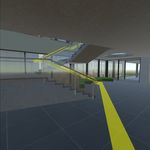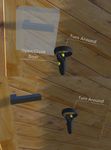Virtual Tour of FIT for Oculus Quest - Michal Jan u* - Excel@FIT 2020
←
→
Page content transcription
If your browser does not render page correctly, please read the page content below
2
http://excel.fit.vutbr.cz
Virtual Tour of FIT for Oculus Quest
Michal Janů*
Abstract
The main goal of this project is to make an application for the Oculus Quest VR headset called
FIT VR. This application has several features that allow the user to do more than just walk freely
around the FIT BUT areal, such as Navigation and Instant travel. The Navigation feature is used to
find the shortest route to the desired office or lecture room and instant travel allows to choose a
starting location.
Keywords: VR tour of FIT — VR FIT — FIT tour on Oculus Quest — VR Oculus quest — Unity
based VR application
Supplementary Material: Demonstration Video
*xjanum03@stud.fit.vutbr.cz, Faculty of Information Technology, Brno University of Technology
1. Introduction e.g. movement, navigation (Section 3), all interac-
The focus of this application is to help students and tive objects (Section 4) such as menus and doors. This
any other users get oriented on the school grounds and allows to make everything exactly as needed, for exam-
help them find a route to the room they need to go to. ple, the default movement in VR is really uncomfort-
Another goal is just to let users explore the areal from able for some people so the application allows the user
the comfort of home and familiarize virtual reality to to set up (Section 5) the movement as they prefer it to
anyone by showing that VR [1] is not just used for be. In order to make FIT VR even more user-friendly,
gaming but that it can be used for something useful. the application provides controller hints (Section 5)
that help the user with the use of controllers.
There already is an existing method to look around
the school and that is with use of 360◦ photos [2] that
are accessible from any device but 360◦ photos do not 2. Oculus Quest
allow the user to go everywhere, unlike FIT VR1 . The headset (Figure 1) is completely wireless thanks
The whole VR application is based on the Unity3D to the mobile CPU that is integrated inside the headset
engine2 that provides the basic building elements. Ocu- and to four cameras that use positional tracking that
lus provides an SDK for Unity3D that enables easier means no sensor stations so the VR can be set up
work with their VR headset and controllers. All mod- practically anywhere. With the headset also come two
els (More in Section 6) appearing in FIT VR1 are done wireless controllers [3].
in Blender3 .
Everything in the application is made from scratch, 3. Navigation
1 Application
for a virtual tour of BUT FIT
For navigation, is used Unity3D’s NavMesh [4] which
2 https://unity.com is used for spatial queries, like pathfinding [5] and
3 https://blender.org walkability tests. The NavMesh creates Mesh thatFigure 1. Oculus Quest headset and controllers
Figure 2. Blue texture on the ground is the generated
Figure 4. In the picture, you can see the user interface
mesh.
of the menu. With opened options tab where the user
can set up the movement and hints. The white line is
representing where the cursor is being directed.
4. Interactive Environment
All interactive objects in the application can be divided
into two categories. One category of interactive ob-
jects are physically interactive objects such as floors,
walls and other objects that have a rigid body (More
in Section 4.1) or colliders (Section 4.1). The other
category of user interactive objects are widgets shown
only for user interaction, for example menus and door
handles.
4.1 Physical Interactive Objects
Physical interactive objects are all objects that have a
visible model (except menus etc.) in terms of FIT VR.
For example, walls and floors have colliders that re-
Figure 3. Visual representation of the navigation. The strict the user from falling through the floor or walk
yellow path shows the shortest path calculated by through walls and doors. The user has control over the
NavMesh. object with a camera that can move on any surface and
has a rigid-body attribute that is restricted by colliders.
represents the walkable area – see Figure 2. It uses
colliders to determine if the path is walkable or not. • Rigid-body It’s component used on the user ob-
NavMesh is used by NavMeshAgent to verify the ex- ject, that applies Unity3D’s physics engine.
istence of a path between the Agent (user) and the • Colliders Defines the physical collision of se-
destination (object). lected object.
With an object present on the mesh selected as
the destination, the NavMesh finds the shortest route 4.2 User-Centered Interactive Objects
through the mesh which is then returned as array of User-centered interactive objects are objects such as
coordinates. To visualise the path all coordinate points menus and door handles, where the user uses con-
are connected by a line-renderer, which highlights the trollers to interact with them. For menus, a prefab
route – Figure 3. The Navigation is extended for re- provided by Oculus is used, whitch uses ray-casting
routing if there is a shorter route existing. from the controller in the direction of its normal andFigure 6. Visualisation of when the controller hints
are enabled and disabled.
Figure 5. Upper image shows visualisation of
ray-cast hitting door handle and the image below
when the ray-cast is not hitting the handle.
then checking if the ray hits any UI element in its path
and visualizes the ray with line-renderer (More in Sec-
tion 3). For door handles, is used a similar script that Figure 7. All currently user accessible buildings such
uses ray-casting from controllers that evaluates if the as buildings A,B,C,L and bridge connecting building
door handle is hit and then a button is pressed for the A and L.
door to be open.
and corridors that normal student has usually access
• Prefab Prefab is an object created as a reusable to. Models for controllers are provided by Oculus but
asset. Such object (prefab) stores all scripts and they had to be modified in the way where all buttons
components applied to it. and joysticks could be highlighted for controller hints.
7. Conclusions
5. Options
Through this application, anyone can explore FIT BUT
Using VR can cause motion sickness to some people.
without having to leave the room. If one is trying to
That’s why the application allows configuring move-
find the right office or lecture room, he or she can use
ment so that the user feels most comfortable. Users
this application to find out the right way.
can configure whether walking and turning are smooth
This application can become much more than it
or not. There is an option to turn on/off controller hints
already is. In the future, the user could walk towards
as well.
any room, for example, the library and opens the UI
window that contains the information about the room,
6. Models such as the current schedule. The model itself could be
All models are made in Blender3 and referenced by combined with 360◦ photos to show a more realistic
building plans provided by Lukáš Duránik and ref- view. Thanks to the Oculus Quest’s mobile CPU that
erences for details of models thanks to 360◦ photos runs android it could be modified to run on any device,
made by Anna Popková. User has access to all rooms not just the VR ones.Acknowledgements
I would like to thank my supervisor prof. Adam Herout
for his help, and Lukáš Duránik for providing building
plans used as a reference for modeling.
References
[1] Grigore C Burdea and Philippe Coiffet. Virtual
reality technology. John Wiley & Sons, 2003.
[2] Yan-Fai Chan, Man-Hong Fok, Chi-Wing Fu,
Pheng-Ann Heng, and Tien-Tsin Wong. A
panoramic-based walkthrough system using real
photos. In Proceedings. Seventh Pacific Confer-
ence on Computer Graphics and Applications (Cat.
No. PR00293), pages 231–240. IEEE, 1999.
[3] VR Oculus. Oculus.[online] available at:
https://www.oculus.com/blog/
introducing-oculus-quest-our-
first-6dof-all-in-one-vr-system-
launching-spring-2019, 2018.
[4] Unity Technologies. Navmesh. https://
docs.unity3d.com/ScriptReference/
AI.NavMesh.html.
[5] Zhang He, Minyong Shi, and Chunfang Li. Re-
search and application of path-finding algorithm
based on unity 3d. In 2016 IEEE/ACIS 15th In-
ternational Conference on Computer and Informa-
tion Science (ICIS), pages 1–4. IEEE, 2016.You can also read


























































